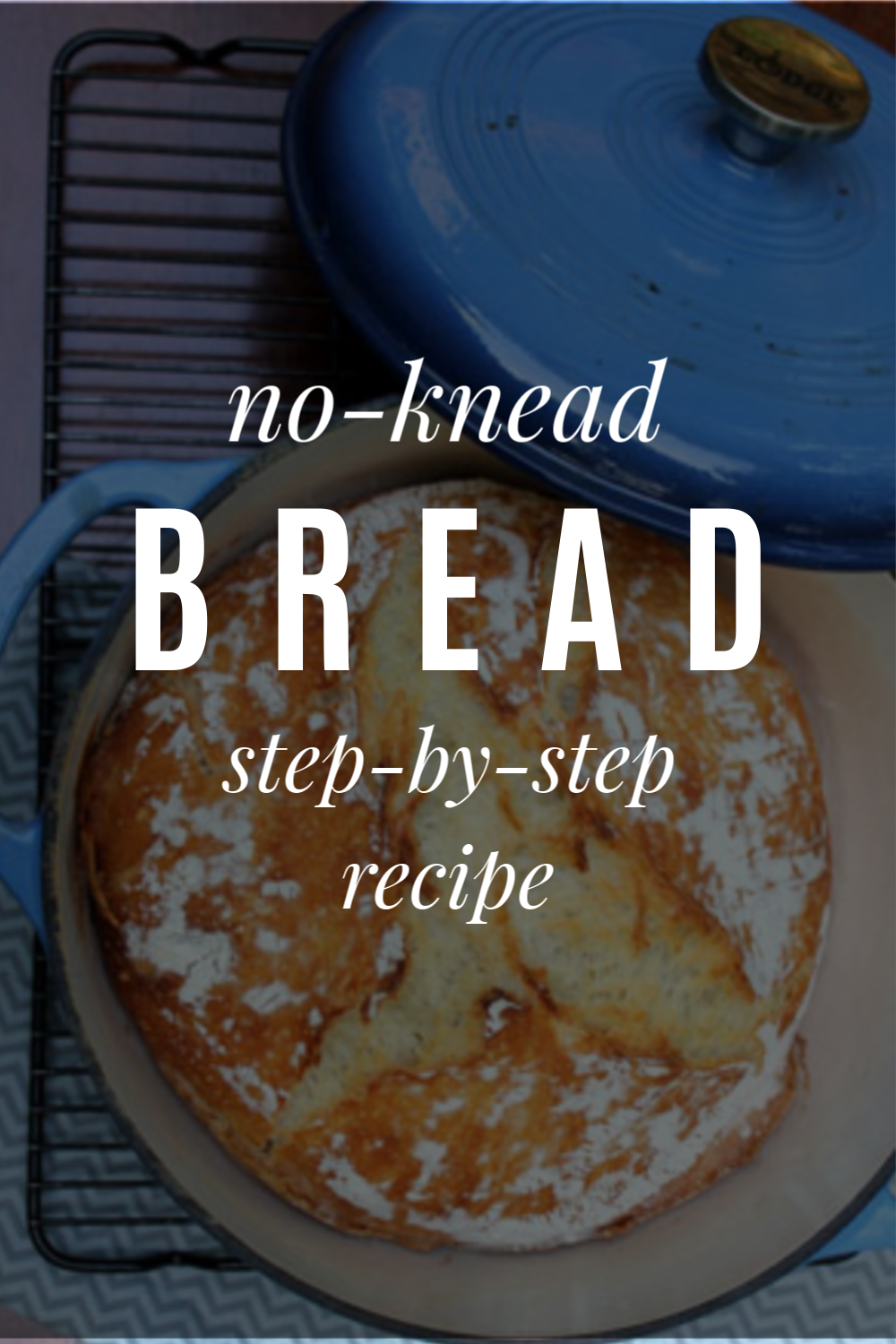
No-Knead Bread Recipe
If you have been hanging out around Frugal Living NW for awhile, you know that I am a big believer in making food from scratch at home. With a few exceptions, I prefer creating something in my own kitchen to buying it in the grocery store.
Bread can be tricky, though. There is some stiff competition out there, and it is tough to replicate a commercial oven’s heat and steam in a normal home kitchen.
For the last several years, I thought that Artisan Bread in 5 Minutes was the best thing since, well, sliced bread. It was simple, and we were content with the results. That is, until last summer when our neighbor brought over a beautiful, delicious loaf of home-baked bread. We had to know her secret. One phone call, and she came back with the book, My Bread by Jim Lahey (Amazon).
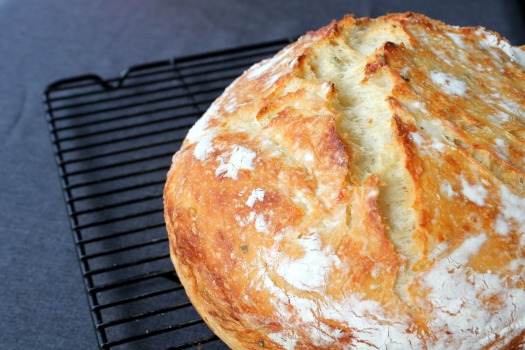
We have been baking bread using this method ever since. I can count on one hand the number of times I have bought bread in the store since then, because I can now make an artisan-quality loaf at home for a fraction of the cost.
I am telling you, this is consistently the best bread I have ever made in my kitchen. Okay, enough gushing. Let’s make some bread.
The only changes I have made to Lahey’s method is to double the amounts and adjust the baking time and temperature to achieve a bigger loaf with a thinner crust.
Oh, and don’t be put off by all these steps. This is totally possible for home bakers at any skill level. I wanted to give you the confidence to do this on your own. A concise recipe can be found at the bottom of this post.
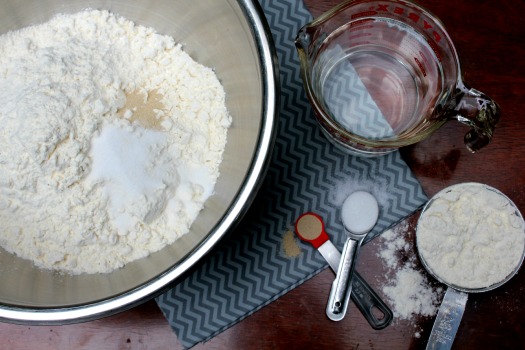
The ingredients are simple: flour, water, salt, and yeast. My husband calculated this bread costs 74¢ per loaf (using Bob’s Red Mill flour & Costco yeast).
Oh, wait! Don’t forget to factor in the roughly 8 cents of energy used to bake it for an hour. No, I’m serious. My husband really does think about this stuff! He’s funny.
So, there you go. A whopping 81¢ for a substantial 2.5 pound loaf of bread. That is crazy cheap.
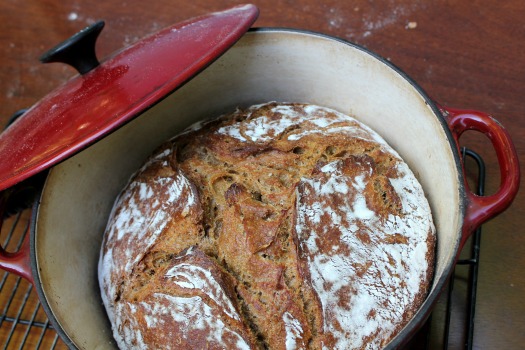
If you want to use some whole wheat flour, substitute 3 cups of whole wheat for 3 cups of the all-purpose flour (3 cups whole wheat and 3 cups of unbleached flour for a total of 6 cups) and add 3 Tablespoons of molasses (optional). This will produce a slightly sweeter, denser loaf of bread. Delicious.
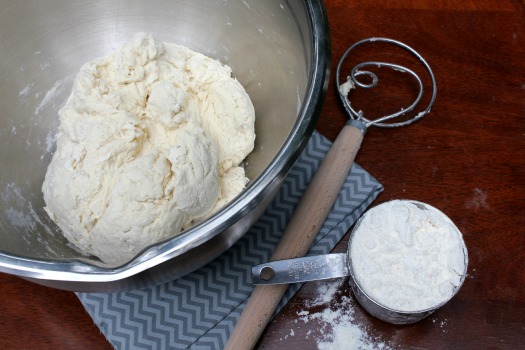
Combine the dry ingredients, add the water, and stir to combine (the funky looking wood-handled item is the amazing Danish Dough Wisk — makes stirring stiff dough a snap). The dough should be wet and sticky. Depending on the temperature and humidity in your home, you may need to add a little more flour or water, 1 Tablespoon at a time. So far, these steps are exactly the same as the 5 Minute method.
The main differences are that you use significantly less yeast (1/2 teaspoon vs. 1 1/2 Tablespoons) and significantly more initial rise time (12-18 hours vs. 2 hours).
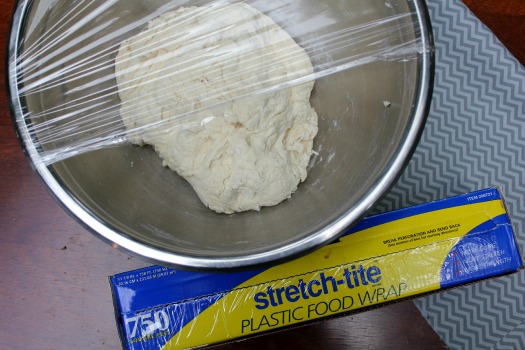
Once the ingredients are completely combined, cover the bowl with plastic wrap and leave it on the counter to rise for 12-18 hours. This slow rise aids in the fermentation of the yeast, giving the bread a better flavor.
Okay, I know what some of you are thinking: 12-18 hours! That’s ridiculous! Who has that kind of time?! I get it.
However, here are two things to consider:
- Once you get into a rhythm of baking your own bread, it’s not a big deal. I start mine in the afternoon or evening and bake it the next morning or afternoon. This would also be an easy weekend routine.
- Just like the title claims, this bread requires no kneading. It is not fussy, temperamental dough. You can produce a delicious loaf of bread with very little hands-on effort & experience.
You’ll know your dough is ready when it has risen in the bowl, smells yeasty, darkened slightly, and is covered with small bubbles.
Using well floured hands, shape and tuck the sticky dough into a rough ball. You can also fold it over a couple times on a well-floured surface. It doesn’t have to be perfect; just keep quickly tucking the dough underneath with your fingertips until you have a semi-smooth dough ball. The dough should be wet but manageable; you don’t want a wet blob so sticky that you can’t shape it into a ball.
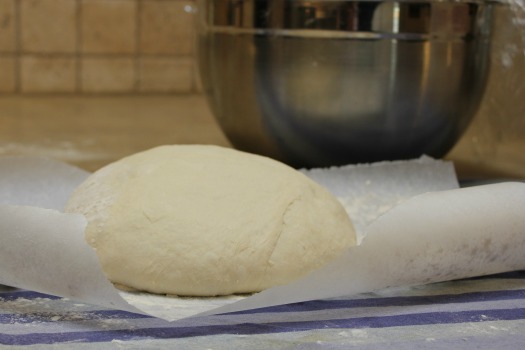
Take a clean linen or cotton tea towel (not terry cloth) and dust it with flour, cornmeal, or wheat germ to prevent the dough from sticking to the towel as it rises. You can also use a floured square of parchment paper on the towel to make the dough ball easier to handle. Place the dough ball, seam side down, in the middle and dust with more flour.
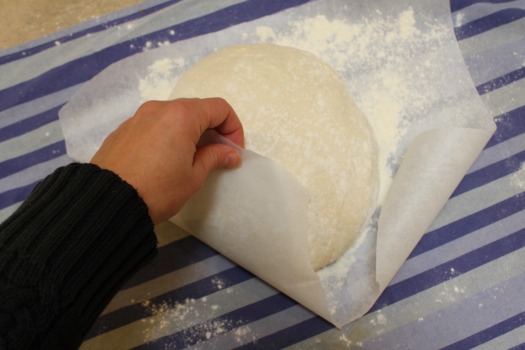
Cover the dough with the (parchment paper and) towel and let it rise for 1-2 hours at room temperature, until doubled in size. During the last 30 minutes of rise time, place a heavy lidded 6-8 quart pot, like a Dutch oven, in a cold oven and preheat it to 425 degrees.
Confession: I own three Dutch Ovens. I use them all the time. They are incredibly versatile and worth the investment. If you don’t own one, you could also make this in any lidded pot, provided it is oven-safe at such high temperatures. Also, check the knob on your pot. If it isn’t rated for such high heat, you’ll want to remove it or cover it with foil. You can also buy an inexpensive replacement knob that is rated for higher temps!
Okay, this is the trickiest part of the entire operation. Remove the lid from the piping hot Dutch Oven, slide your hand underneath the towel or parchment paper, and flip the risen dough (seam side up now) into the pot. Try to flip close to the pot or the flour will fly everywhere. Remove the towel or paper and set aside.
This might take a bit of practice, but again it doesn’t have to be perfect. Some of my worst flips have produced my most beautiful loaves. I love what Lahey writes, “…even the loaves that aren’t what you’d regard as perfect are way better than fine.”
Place the lid back on top and slide the pot back into the hot oven.
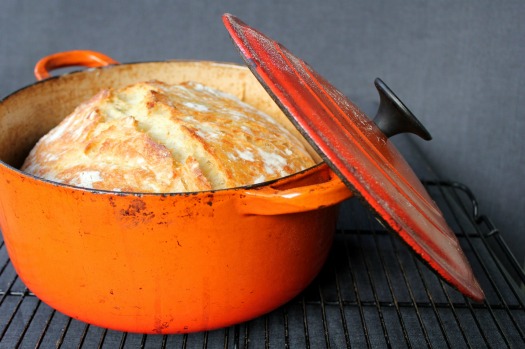
Bake it for 40-50 minutes. Remove the lid. Bake for another 5-10 minutes, until golden chestnut brown. The internal temperature should be around 200 degrees. You can check this with a meat thermometer if you’re nervous about knowing when your loaf is done.
Oh man, your house will smell so good about right now.
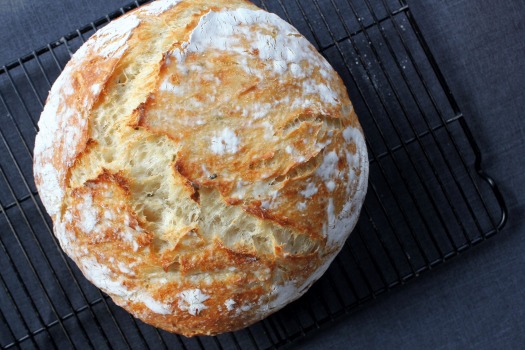
Place the loaf on a cooling rack. You will hear it crackling as it cools. Use every ounce of self-control to resist cutting into it until it is “quiet”; cutting it too soon will make the bread dense and gummy.
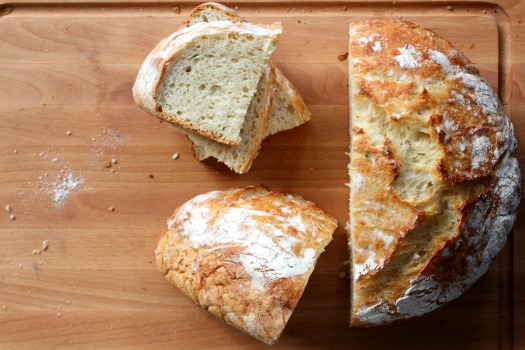
This bread is best the first 2-3 days. I just store my leftover loaf inside the Dutch oven on the countertop. Using plastic wrap will soften the crust. Dry, leftover bread makes great bread crumbs, toast, French toast, or croutons!
Enjoy. And pat yourself on the back. You just baked an amazing loaf of bread!
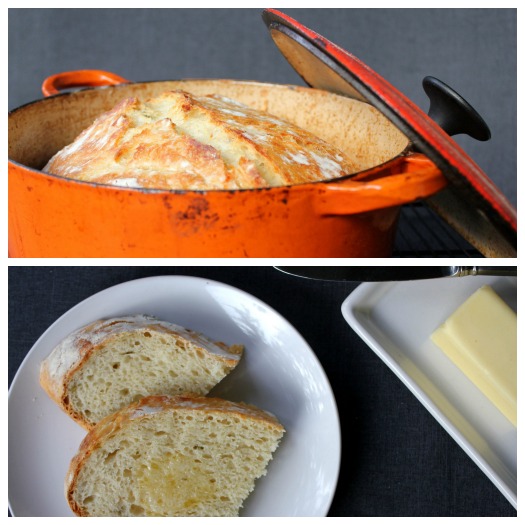
Basic No-Knead Bread
Slightly adapted from Jim Lahey’s My Bread
Ingredients
6 cups bread flour (recommended) or all-purpose flour, plus more for work surface
1/2 t. instant or active-dry yeast
2 1/2 t. salt
2 2/3 c. cool water
- In a large bowl, combine the flour, yeast, and salt. Add the water and stir until all the ingredients are well incorporated; the dough should be wet and sticky. Cover the bowl with plastic wrap. Let the dough rest 12-18 hours on the counter at room temperature. When surface of the risen dough has darkened slightly, smells yeasty, and is dotted with bubbles, it is ready.
- Lightly flour your hands and a work surface. Place dough on work surface and sprinkle with more flour. Fold the dough over on itself once or twice and, using floured fingers, tuck the dough underneath to form a rough ball.
- Place a full sheet/large rectangle of parchment paper on a cotton towel and dust it with enough flour, cornmeal, or wheat bran to prevent the dough from sticking to the parchment paper as it rises; place dough seam side down on the parchment paper and dust with more flour, cornmeal, or wheat bran. Pull the corners of parchment paper around the loaf, wrapping it completely. Do the same with the towel. Let rise for about 2 hours, until it has doubled in size.
- After about 1 1/2 hours, preheat oven to 425 degrees. Place a 6-8 quart heavy covered pot, such as a cast-iron Dutch oven, in the oven as it heats. When the dough has fully risen, carefully remove pot from oven. Unwrap the towel and parchment paper from around the dough and slide your hand under the bottom of the dough ball; flip the dough over into pot, seam side up. Pull the parchment paper off, scraping any stuck dough into the pan. Shake pan once or twice if dough looks unevenly distributed; it will straighten out as it bakes.
- Cover and bake for 40 minutes. Uncover and continue baking for 10-15 more minutes, until the crust is a deep chestnut brown. The internal temperature of the bread should be around 200 degrees. You can check this with a meat thermometer, if desired.
- Remove the bread from the pot and let it cool completely on a wire rack before slicing.
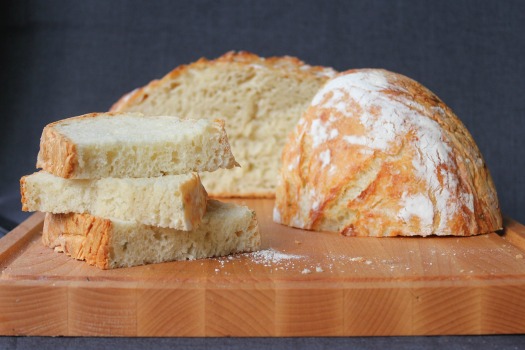
Here are a couple options for Dutch Ovens. Any heavy, lidded 5-8 quart pot (seasoned cast iron or enamel coated) would work with this recipe. Lodge has the best prices/options for dutch ovens on Amazon.
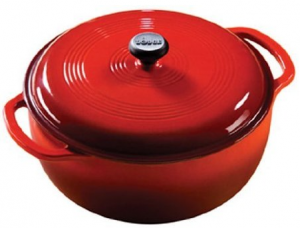
Lodge Logic Dutch Oven in Island Spice Red (6 Quart)
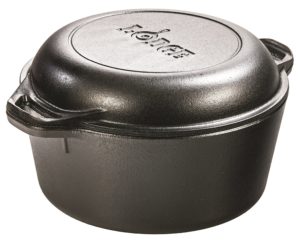
Lodge Cast Iron Double Dutch Oven (5 Quart)
If you already have a dutch oven (or find a deal on a lesser-known brand) that doesn’t have a knob rated for high temps, replace it! There are some really affordable options.
Got questions? You are in good company. Go here for the complete FAQ list.
Looking for more variations to the no-knead bread recipe? We’ve created a list with sweet and savory varieties, including the following:
- Cranberry Orange
- Four Cheese
- Sandwich Bread
- Dark Chocolate Coconut
- Tomato Basil Cheese
- Whole Wheat
Looking for more delicious bread recipes?
Find more delicious recipes on our Recipe Page!
Follow Frugal Living NW on Pinterest!
Fantastic range of boards from best recipes and tips for frugal living to gardening and budgeting help.
This post may contain affiliate links. See the disclosure policy for more information.
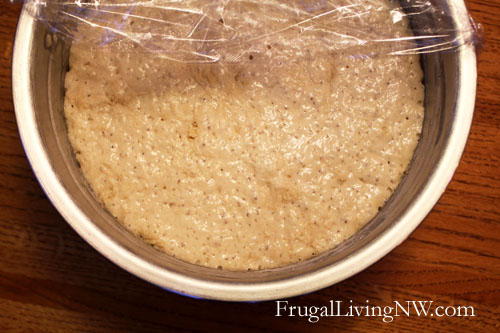
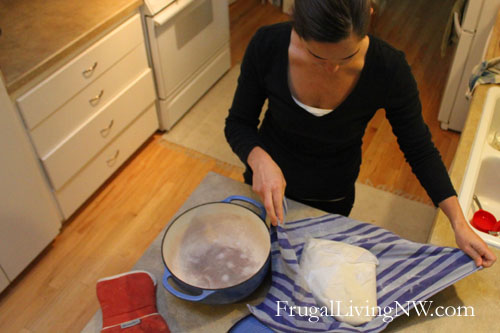
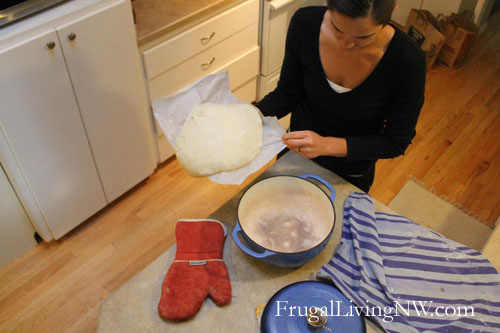

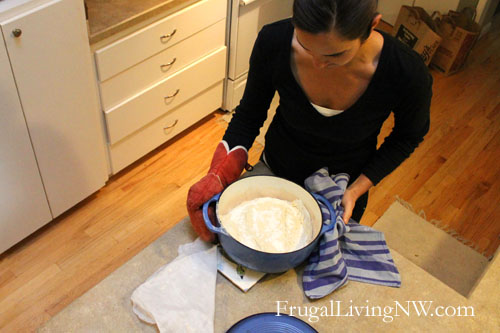
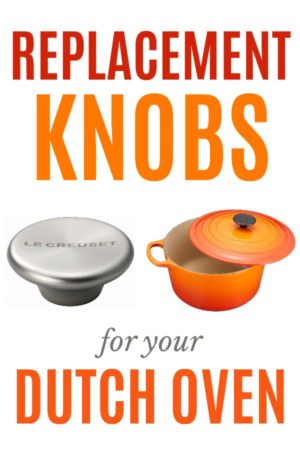

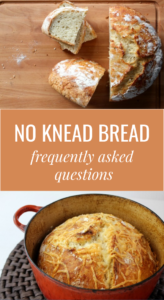
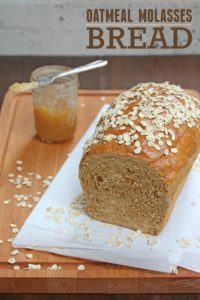
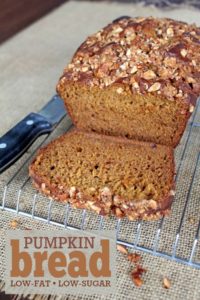
Thanks so much for sharing this recipe, and for doing the work to double the dough effectively! I have made versions of the Lahey recipe for several months now and loved them all. This version was outstanding – something about the double-size boule accentuated the contrast between crackly, delicious crust and lots of soft, pillowy crumb inside. Love it!
Thank you so much for sharing this with us. Could you please tell me what should I do in order not to get such a hard crust? We would like a bread with a normal crust. Thank you again.
Can these breads be made in a loaf pan instead of a dutch oven?
What about fresh yeast? How much of that for this recipe?
Tks
H.E.L.P. – I would like nothing more than to master this recipe. Have tried it twice and twice I got the same results. Followed the recipe exactly, specifically,…to the “T”. Still the results were no where as illustrated. First try resulted in a thick, hard crust (nearly cracked a tooth!), with a thick, heavy and dense inner bread. No nooks and crannies. Second attempt was pretty much the same but since I pulled it out before browning too much, the crust wasn’t as hard. I know from past baking experience, I am NO baker but this is one I thought I’d have no problem since it sounds SO easy. I would appreciate any help since this is one baking hurdle I really want to accomplish because my troop at home inhales ANY artisan bread within 50 feet of them. Thanks so much.
Queene, without being in your kitchen I am guessing here, but I’ve found a few small things can make a difference with no-knead bread. My best guess is that your yeast did not activate.
– If you use active dry yeast, be sure to soak it in some of the water at lukewarm temperature (110-120 degrees) for 5 minutes before adding to the flour, to activate the enzymes. Supposedly you can skip this step on a long rise in wet dough like this, but I’ve not found it to work well. Or better yet, just get instant yeast – that’s what I use now.
– Make sure your dough is well mixed before you set it aside for that long rise. Although I don’t *knead* the bread per se, I want to make sure that the water is distributed throughout so I don’t end up with a big craggy dry part at the bottom. I add the water in small amounts and keep mixing as I go.
– Another thing to try is just adding a little more water than is called for in this recipe – the Lahey recipe in the book (for a loaf half this size) calls for 1-1/3 cups of water; the Mark Bittman NYTimes version has 1-5/8. My experience has been that the extra water may result in not quite as much “lift” during the bake but it helps hugely with the mixing.
I just made the bread, it’s all we can do to wait for it to cool. It looks better than store bought, I’m super excited to taste it. Thank-you. Linda
The best Bread i ever made. So light and airy with a hard crust. is even better when you toast it. I didn’t have a dutch oven, so i used the insert from my crock pot with a ton foil cover. Worked perfect. It was very easy to make but it was hard to let the bread cool before cutting. The house smells heavenly. I’m on my third loaf, using some whole wheat flour and rye flour. Thanks for the recipe! ???
Just tried making this for the first time. It never really rose correctly, either time. Could my house we too cold? I let the first rise sit for 16 hours and no change from the 13 hours.
Help
Thanks!
Lindsay
I’ve found that using warm water when making the dough helps the yeast along (not hot–that will kill the yeast). I let my bread rise in an oven that was turned on for about 1-2 mins then immediately turned off. Keeps the draught out. Put a note on the knobs so you don’t accidentally preheat the oven for something else — you’ll kill your dough and the plastic wrap will melt. Disaster. Good luck!
Did you store it somewhere warm and covered? Winter is THE best time for me to make this bread. I have wall heaters in my apartment. I put the bread on a footstool about 4 feet from the heater, turn the heat to 75, and shut the door for the night. It comes out puffed up and *SUPER* fluffy when baked.
Summer, I use the oven trick. Turn it on for maybe 5 minutes and turn it off. Give it a few minutes to cool and put the bowl in (covered heavy in saran wrap).
Hi Lindsay, I turn on the light in my oven and leave the dough in there with a wet towel over it. Then I don’t have to worry about melting anything ect. Is your yeast alive?
If you are using instant yeast, it should work. If you are using active dry yeast, you need to proof it first. Put the half teaspoon of yeast in a quarter cup very warm water (94 degrees F to 105 degrees F, try to keep it under 110 degrees of you’ll kill the yeast). Warmer tap water will be fine, no need to heat the water any other way. Leave it to proof for 5-10 minutes (a few bubbles and/or foam means it is working) and then add it in with the other ingredients. I choose to add my proofed yeast to the rest of the water before I add it in. If the yeast isn’t instant or proofed, then it won’t rise.
Thanks so much, I’ve been wanting to have my single portion loaves rise higher, I’m going to try proofing the yeast to get a higher rise. I’ve just tried this recipe for a one day rise and cook (has a great video) . it produces the same bread as this frugal living recipe, which I now use when I want an overnight rise. http://www.jennycancook.com/recipes/faster-no-knead-bread/
If anyone has other suggestions on getting a higher rise from the single portion recipe, I’d appreciate hearing them. Thanks, Kaye
Hi,
A neighbor just came over and gave me one of those older stoneware crockpot dishes with the glass lid. Has anyone tried using it as a bread baking pot? Can it withstand the high baking temps? Thanks very much. Kaye
I’ve never used mine, but what a great idea. I think this would work fine. What have you got to lose, unless this pot it important to you. Let us know how it worked out for you.
When I make half the recipe I use a Pyrex casserole and have never trusted it in higher temps. I bake mine at 385. I bake it for about the same amount of time but always use an instant read thermometer to make sure it is done – 185-190 is about right.
Can you tell me how much wild yeast to use instead of commercial. I am interested in trying your recipe but want to use wild yeast.
Is wild yeast like starter yeast?
Would you use the same amount of yeast if it were bread machine yeast?
Hi, I absolutely LOVE this recipe!
I was wondering if anyone has tried this with gluten free flour???
Thank you!
This question is when you are adding sourdough starter instead of using yeast. How long do you let the bread rise?
can you use self rising flour
Thank you for this recipe. I have made this several times and love it. After shaping I put it in the bowl on top of parchment and then just transfer the parchment with dough in it to the hot pot rather than flipping it, Works great. Nothing sticks to the pot or the paper. Just saw the post about not needing a second rise and I’m going to try that with the next one and see how it goes. The variations you have suggested sound great too, I think I will be experimenting a lot with the cooler weather coming. Keep the recipes coming please!
I’ve made this bread several times and always get rave reviews; my daughter calls it my “pot bread”!
This is the second time I’ve tried such a recipe–the first time with yours. Mine looks just like yours up until the time I scoop the dough from the bowl after the first rise. Then it’s a very loose mess. When you say to “add flour” do you mean copious amounts of flour? Because that’s what I had to do in order to get it to resemble your dough ball! It’s on the second rise now–looking forward to good results, fingers crossed.
I let it rise the second time on parchment and then move the whole thing, parchment and all to the pot. That helps a lot.
Just shared this on my blog, hope you don’t mind! I seriously cannot wait to make this (even though I do own a bread machine, go figure)!! -Michelle
I have a bread machine too, but I can’t imagine this bread being made any way other than it’s shown in the directions. Best. Bread. Ever!
This is the best homer made bread I’ve ever made and ate. The recipe is a keeper and my go-to bread recipe.
Thanks Angela
I can’t wait to try and make this! I love bread and this looks amazing. Thanks for sharing!
We love this bread! It is so delicious! Have made it with King Arthur’s whole grain only and it turned out great!
The loaf is huge though! Has anyone tried using half of the ingredients or baking two loaves? What size dutch ovens would you use and at what temp for how long?
Thanks!!
I always cut the recipe in half unless we are having a meal with lots of people. I also cut the amount of salt. For half the recipe I use a 2 1/2 qt Corningware casserole dish w/cover. I preheat the dish in the oven just as you would the Dutch oven, but not the glass lid. When the casserole dish is hot dump in the dough, put on the cover and bake. I have to adjust the baking time a bit – doesn’t take as long as with the large loaf. If I make the original recipe I use a 5 1/2 qt Dutch oven. Cheddar chive is our favorite bread.
Thanks Kathi for sharing that you use a 2 1/2Qt corningware casserole dish for 1/2 receipe. In the past I was making a whole recipe, but now that I’m recovering from a broken back that’s too heavy and cumbersome for me. there are some great sales going on now and I’ve just ordered a ccountertop convection oven so I don’t have to bend, and Ive just found corningware on saleI’ll order a casserole dish so I can bake my bread again. QUESTION: do you dump the dough in the hot dish directly? or do you put parchment paper in it? Thanks so much.
Almost forgot… spray parchment with oil… No stick to paper or pot,,,
Second rise… line large wok with parchment, dump in dough… use paper as handle and set in heated pot after rise. Bake as directed. Again use paper as a handle and turn on cooling rack. I re-use the paper 2 or 3 times. Easy peasy…..
Even more “easy peasy” is to completely skip the second rise (read my other posts). You really don’t need to do it–unless you just like playing with your food.
i made the plain loaf for the first time in February. Turned out beautiful but, since I live alone, ended up freezing half of it. It does freeze well. I’m trying one of the variations today (tomato basil) and the dough is on the second rise and smells amazing. I didn’t have any of the problems with sticking and I followed the directions exactly. I have reserved two cotton towels specifically for bread making and they come completely clean after a good wash (then hung to dry and put back in the Dutch oven for storage). My fiancé was worried we’d have to ‘baby sit’ rising dough all weekend but was surprised how hands off this recipe really is.
I have made no knead bread several times using plain flour. I then wanted to try whole wheat flour but kept getting bread similar to a curling rock! Yesterday after reading several of these posts, I tried a loaf with 2 cups whole wheat and 4 cups regular flour, and a scant tsp of yeast. I lined a bowl with plastic wrap and brushed with oil to put the dough in after mixing as I always had trouble with flipping from floured towel into hot casserole. Before I flipped, I gently ran a spatula down the sides of the dough to make sure no dough was sticking. With a small sieve I sprinkled a bit of flour on top the dough so it would not stick to the bottom of the casserole. It was very easy to then flip into the hot pot. The results were very good, with a lighter dough, and I will definitely make again, possibly with some added whole mixed grains instead one cup of WW flour. I think you have to find what works for you..as this did for me!
Try one cup of real oatmeal to sub for a cup of flour. Also… there is self rising flour out there.
Has anyone tried cinnamon raisin?
How about cinnamon diced apple? A cup of apple juice for a cup of water? Now I can wait to try this… such a genius…
I live at 6500 feet. Any suggestions for high altitude baking? For instance, when I make cornbread I add an extra egg. Also if I’m cooking or baking I always need to cook/bake a little longer than the recipe says. Thanks.
I live at 7100 feet and have no problems. I do let it rise for 14 hours and then 2 more hours after shaping the bread. It is delicious.
Thanks Carol,
This is my first adventure with yeast bread. I did follow the recipe, and added just a tad more of water. When I woke this morning I was astonished to discover how much the volume had increased (I must have done something right!I) It was so much it completely filled my 6 quart stew pot. It had bubbles but no color change so I waited 2 hours to see if the color would change. So I decided to forget about the last 2 hours, I really didn’t want more volume. I heated the oven and got my 8 quart stewpot ready. I shaped the loaf and did a parchment liner so I could easily lift the loaf out once it’s done. It’s in the oven now. Went for a dog walk and am now awaiting the magic. Thanks for your help. Kaye
I made this bread for a family get-together. To anyone reading the comments wondering if it’s really as easy as they say, or if it’s really worth the time, or in any other way hem hawing around, please listen to me when I say, DO IT RIGHT NOW! This bread is everything. I followed the recipe exactly, using active dry yeast. It came out perfect. And it’s beautiful. It looks like a $9 loaf of artisan bread. Emily, I’m so glad I pinned this and tried it. Thank you! I’ll never make another bread recipe.
This is amazing! I have been struggling to find a good “easy” bread. Started it last night before I went to bed, now my house smells amazing and I’ve got the prettiest homemade loaf of bread waiting to be apart of dinner tonight. Pinned It, Blogged It, called all my friends about it! Thanks!
I’ve never made bread before – except for banana bread…but that doesn’t count. After my beautiful loaf was cool, my husband tried it and with excitement in his voice said “This tastes just like the bread we used to get in Germany when I was a kid!” Thank you so much for posting this recipe!!!
After my beautiful loaf was cool, my husband tried it and with excitement in his voice said “This tastes just like the bread we used to get in Germany when I was a kid!” Thank you so much for posting this recipe!!!  Your directions are so well-written and with the pictures, so easy to understand. Thank you a hundred times!!!
Your directions are so well-written and with the pictures, so easy to understand. Thank you a hundred times!!!
Hi! I just made this recipe using 1/2 whole wheat (although I forgot the molasses!) and it is nice and moist – however, I have smaller bubbles at the bottom of my loaf, and big huge bubbles at the top, almost separating the upper crust from the interior. Any ideas on what this might mean? Did I do the fermentation or proofing too long? I hadn’t read about this happening before – and I’ve been reading a lot.
Also, what’s your take on using a 4qt pot instead of a 6 qt pot to get a rounder shape?
Thanks so much for this recipe!
I use my Lodge cast iron 4 qt. pot and it turns out great. More of a ball shape and it has always turned out great. Hope this helps.
I just successfully mixed this whole recipe in my 1500 watt Ninja Professional Food Processor. That things a beast if it can take this bread dough! Can’t wait to bake it and take to share with everyone at work in the morning!
Just baked my first Dutch Oven bread. I have never baked anything outside of a frozen pizza. After 18 hours of rising I thought I used too much water as the dough was sagging and sticky. It literally plopped into my Dutch oven. When I took off the lid after the initial baking, the dough has risen into a nice ball. When completed, my bread looked just like the pictures.
Excuse me now as I try a slice of this wonderful smelling bread.
maybe a ridiculous question. But is the water measurement 2 cups and 2/3? OR 2 of 2/3 cup?
Thanks!
There are no dumb questions around here! It’s 2 and 2/3 cups of water. Happy baking!
Sorry for asking this silly question, but is this whole recipe for only one loaf of bread? I’m confused because I use the artisan bread in 5 minutes recipe and it makes multiple loaves. Thanks in advance for helping.
this recipe makes two loaves. if you want to make only one, just cut everything in half.
This recipe will actually give you one huge loaf of bread. Cut everything in half for a smaller loaf or make as written and separate the dough into 2 equal parts. Bake in 2 Dutch ovens/pots for 2 smaller loaves. One could be eaten right away and one frozen for later, so this isn’t a bad route if you aren’t feeding many people!
I have been trying to bake this bread several time and each time I seem to have the same problem … for some reason it does not rise as much as I would like it to and therefor creating a bread that is a bit flatter then what I would like. Any suggestions?
Thanks
I made this bread today for the first time. It is absolutely great! I added molassas and used half whole wheat flour. Amazing flavor and texture. And, a big beautiful loaf of bread.
I forgot to add, I have been out of parchment paper for some time and I use a clean pillow case, well floured, and the dough does not stick to it. It is smoother than a towel.
That’s a great tip (and a nice savings if you make this bread often). I don’t understand why parchment paper is so expensive…
YOU DON’T NEED THE TWO STEP RISING PROCESS!
I posted a long time ago how you can just mix the flour, yeast, salt, and water–then let it rise in the same bowl for 12 – 24 hours or so and then dump it directly into the heated baking pot.
Trust me–I’ve been making this for potlucks for several years, and it turns out exactly the same without the hassle of turning it out on a towel, etc. MIX IT AND BAKE IT–THAT’S IT!
Thanks Dave!
That is the way Jim Lahey does it on his video, but every recipe I see shows the 2nd rise. I have been searching the internet to find out if the 2nd rise was necessary. I am trying it with just the one rise.
After rising, the dough will be moist and sticky, so I use a flour sifter to liberally sprinkle flour around the edge and immediately scrape the dough from the sides of the bowl with a stiff rubber or silicone spatula–and the flour will then coat the dough all over. Once it’s loosened all around and coated with flour, it’s ready to roll into the heated pot.
Has anyone tried making a loaf or dutch oven, or whatever, using a small chunk of dough from your last loaf? It’s what they did long ago and far away. :-0
It comes out just fine without added yeast. And it’s not energy intensive or having to fuss over starters, and if a friend wants some, cut off twice as much. I like 1/2 C, and it works great. Keep in fridge in a wide-mouth pint mason jar, covered. Wash jar and lid while waiting for dough to rise. Let warm to room temp before using. Basically, it’s the same principle as a starter, but the additional flour to feed it comes from the new loaf. Add after adding fluids to the flour and knead it right in, and let rise as normal. You may need a little more depending on humidity, but 1/2 C has never failed.
I have made this recipe several times, always happy with the bread. Then last night I read a lot of comments and the suggestion of oiling the bowl and letting it raise there the second time sounded like a great idea. So I did it and when it was baked, it stuck so bad I pretty much ruined the loaf trying to get it out. I say, stick to this recipe! It doesn’t stick at all if well floured.